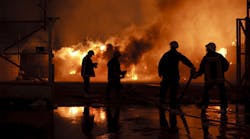In the 2014 Edition of the National Electrical Code (NEC), the last sentence of the first paragraph in Sec. 500.5(A) states: “Where pyrophoric materials are the only materials used or handled, these locations are outside the scope of this Article.”
Pyrophoric materials can spontaneously combust in water or air at or below 55°C (130°F). The higher the ambient humidity or temperature, the more volatile these materials can be. While not common in every industrial process unit, these materials do exist in some form (liquid, solid, or gas) in most petrochemical plants and refineries.
In refineries for example, steel crude oil tanks, asphalt tanks, and reactors are common sources for the formation of pyrophorics. Hydrogen Sulfide (H2S) combined with rust from steel tanks or pipes can create iron sulfide, which is a pyrophoric, and can ignite, if exposed to air.
It’s very difficult to know when and where pyrophorics may exist, so proper maintenance and inspection of all equipment is necessary. The other downside to pyrophorics in a petrochemical facility is an unexpected pyrophoric combustion may trigger another ignition of nearby hydrocarbons leading to an even greater hazard.
While pyrophorics are not addressed directly by the NEC, they are a potential hazard and should be considered as a source of ignition where possibly present.
© 2014 Fluor Corporation. All Rights Reserved.



